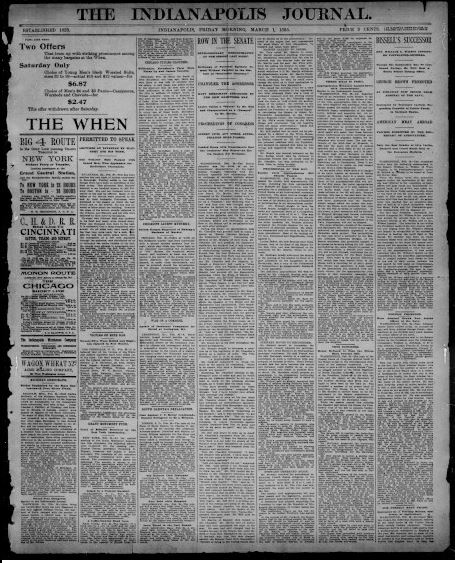
Access 32 years of the Indianapolis Journal (1872-04)!
In 1825, Indiana state printer John Douglass relocated with the state capital from Corydon to Indianapolis, then a town with less than 1,000 residents. Douglass had previously published the short-lived Madison (IN) Western Clarion, and upon arriving in Indianapolis purchased a share of the Western Censor and Emigrants Guide. Douglass and his partner, Douglass Maguire, changed the name to the Indiana Journal, and produced their first issue on January 11, 1825. The anti-Jacksonian publishers advocated for government sponsored internal improvements and protective tariffs that would aid Indiana’s agricultural economy. These political positions led the Journal to align with the emerging Whig Party in the 1830s.
Beginning in 1839 the publishers increased and varied the Journal’s publication frequency based upon when the Indiana General Assembly convened; what had hitherto been a weekly edition, became semi-weekly, tri-weekly, and daily at different times from 1839-1851 to accommodate more state legislative news. In 1840, Douglass and his new partner, Samuel V. B. Noel, also issued a campaign newspaper, the Spirit of ’76, which supported former Indiana Territorial Governor William Henry Harrison’s Whig candidacy for President of the United States. After eighteen years operating the Journal, Douglass sold his interest to Noel in 1843. Noel only maintained sole ownership of the paper for two years, but during that time he changed the name of the paper to the Indiana State Journal, and he allowed Henry Ward Beecher to edit and issue the Indiana Farmer from the Journal’s presses.
John D. Defrees, former publisher of the Northwestern Pioneer and St. Joseph Intelligencer in South Bend, acquired the Journal in 1845 and operated it until 1854. Defrees continued the Journal as a Whig organ, and the paper’s editorials criticizing the Democratic administration’s conduct of the Mexican-American War echoed Whig rhetoric heard around the country. Defrees’s use of the Journal to spread Whig ideas made him an important Indiana political voice, and when the Whig Party collapsed in the early 1850s Defrees became an important leader in the fusionist movement that established the Republican Party in Indiana. Defrees also made several important changes to the Journal and Indiana journalism. He installed the city’s first steam driven printing press, expanded the page format from four to six columns, and introduced better quality illustrations. Defrees also conducted a fierce rivalry with the Democratic Indiana State Sentinel, and introduced Indianapolis’s first permanent daily, the Daily Indiana State Journal, one week before the Sentinel’s daily premiered in April 1851. The daily edition’s title changed to Indianapolis Morning Journal in 1853, the Indianapolis Daily Journal in 1854, and simply the Indianapolis Journal in 1867. The fledgling Indianapolis Locomotive, the brain-child of some Journal apprentices in 1845, demonstrated the reading public’s appetite for more local and society news. The Journal’s daily production schedule created room for local stories, and next day reporting.
One of the most important nineteenth-century Indiana journalists, Berry R. Sulgrove, joined the Journal in 1854 as editor. Sulgrove also wrote much local news copy. He acquired controlling interest in the Journal by 1856, and transitioned the Journal from Whig into the Republican camp. During the Civil War, Sulgrove penned strong Unionist editorials that supported the policies of President Abraham Lincoln and Governor Oliver P. Morton. During the war, the Journal’s daily circulation reached 6,000; for comparison the city’s pre-war population was 18,611.
Indiana had a bustling literary scene in the late 1800s, which was due in part to the Journal’s managing editor Elijah W. Halford’s advocacy and support of Hoosier authors. James Whitcomb Riley, the “Hoosier Poet,” greatly benefitted from Halford’s patronage. Riley published hundreds of poems and humor pieces in the Journal from 1877-1901, and also worked as a Journal reporter for few years.
In 1880, John C. New became Indiana’s Republican Party Chairman, and purchased the Journal. New’s greatest success as a political operative and a newspaper publisher was his advocacy of Benjamin Harrison for the Republican presidential nomination in 1888. New first suggested Harrison for president in 1884, and redoubled his efforts in 1888. He avidly promoted Harrison’s candidacy in Journal editorials, and distributed thousands of Journal issues among delegates at the Republican National Convention that subsequently nominated Harrison. The Journal’s role in Harrison’s nomination and subsequent election to the presidency elevated the newspaper’s national profile.
The increased profile, however, did not translate to better sales. In 1890, the Journal’s daily circulation of 8,263 was paltry compared to its competitors the Indianapolis News with 21,468 and the Sentinel with 15,800. In the late 1890s the Journal faced even more competition from yellow journalism that used sensational headlines to drive sales. The ever respectable Journal editors explained, “The Journal refuses to put itself on a level with the cheap papers flooding the country, and therefore appeals only to that class of reading public which wants the news presented in a decent and dignified manner.” The Journal managed to boost its daily circulation to a high in 1901 with 22,320, but in a city of 170,000 the News remained the leader with almost 50,000 daily issues in circulation. Three years later in June 1904, George McCulloch, publisher of the recently established Indianapolis Morning Star, purchased the Journal. McCulloch issued the paper as the Indianapolis Morning Star and Journal until October 26, 1904 when he dropped Journal from the title.
Bibliography
Irby, Harold F. “A History of the Indianapolis Journal” Master’s thesis, Butler University, 1936. Access it here: http://digitalcommons.butler.edu/grtheses/224/
Miller, John W. Indiana Newspaper Bibliography. Indianapolis: Indiana Historical Society, 1982.
“Berry R. Sulgrove, Journalist,” Indiana Magazine of History 1 (1905): 139-147.
Sulgrove, Berry R. History of Indianapolis and Marion County, Indiana. Philadelphia: L. H. Everts & Co., 1884.
